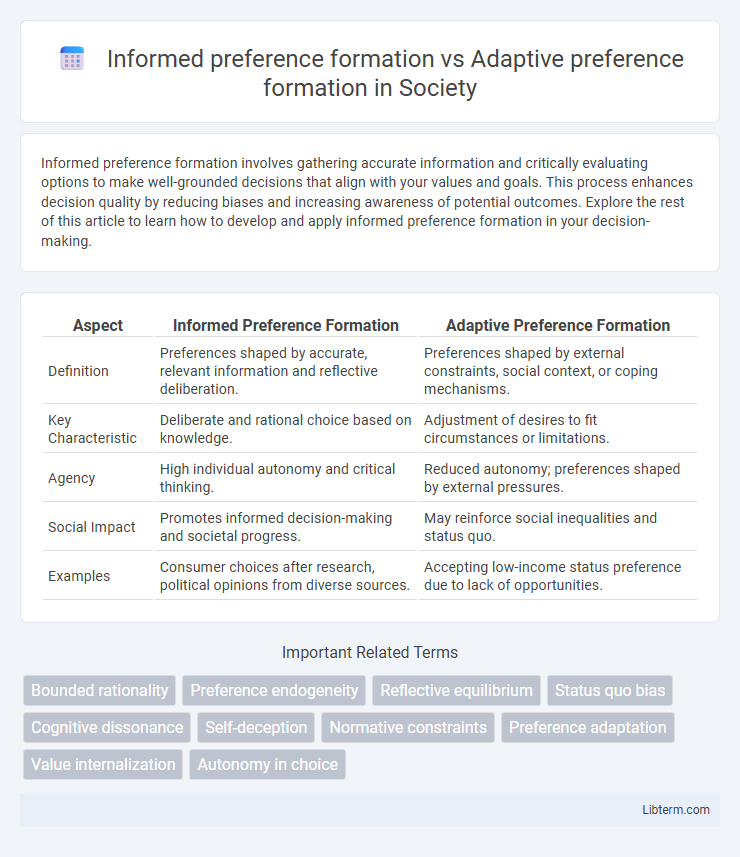Informed preference formation involves gathering accurate information and critically evaluating options to make well-grounded decisions that align with your values and goals. This process enhances decision quality by reducing biases and increasing awareness of potential outcomes. Explore the rest of this article to learn how to develop and apply informed preference formation in your decision-making.
Table of Comparison
| Aspect | Informed Preference Formation | Adaptive Preference Formation |
|---|---|---|
| Definition | Preferences shaped by accurate, relevant information and reflective deliberation. | Preferences shaped by external constraints, social context, or coping mechanisms. |
| Key Characteristic | Deliberate and rational choice based on knowledge. | Adjustment of desires to fit circumstances or limitations. |
| Agency | High individual autonomy and critical thinking. | Reduced autonomy; preferences shaped by external pressures. |
| Social Impact | Promotes informed decision-making and societal progress. | May reinforce social inequalities and status quo. |
| Examples | Consumer choices after research, political opinions from diverse sources. | Accepting low-income status preference due to lack of opportunities. |
Understanding Preference Formation: An Overview
Informed preference formation occurs when individuals develop choices based on comprehensive information and deliberate evaluation of options, enhancing decision quality and satisfaction. Adaptive preference formation refers to the process where individuals adjust their preferences to align with available options or constraints, often as a coping mechanism under limited information or external pressures. Understanding these mechanisms is crucial in economics and psychology for designing systems that improve decision-making and welfare outcomes.
Defining Informed Preference Formation
Informed preference formation involves individuals developing preferences based on complete and accurate information, enabling rational decision-making aligned with their true values and needs. This process contrasts with adaptive preference formation, where individuals adjust their preferences based on limited options or external constraints, often leading to satisficing or lowered expectations. Defining informed preference formation highlights its foundation on transparent, comprehensive knowledge that empowers genuine choice rather than compromise.
The Concept of Adaptive Preference Formation
Adaptive preference formation describes a psychological process where individuals unconsciously adjust their preferences based on their current circumstances and available options, often to reduce cognitive dissonance or cope with limitations. This concept contrasts with informed preference formation, which assumes preferences are shaped by comprehensive information and rational evaluation. Adaptive preferences emphasize the role of situational constraints in shaping desires, highlighting how preferences may not always reflect true individual values but rather an adaptive response to external factors.
Psychological Foundations of Preference Development
Informed preference formation relies on individuals acquiring accurate information and evaluating alternatives based on cognitive processing, emphasizing the role of knowledge and rational deliberation in shaping preferences. Adaptive preference formation highlights how preferences evolve reactively to constraints or limited options, reflecting psychological mechanisms such as cognitive dissonance reduction and self-justification to align desires with available realities. Both frameworks are grounded in psychological theories involving decision-making processes, cognitive biases, and motivational factors that influence how preferences develop and change over time.
Key Differences: Informed vs Adaptive Preferences
Informed preference formation is characterized by individuals making choices based on comprehensive, relevant information, allowing for rational and well-grounded decisions aligned with their true values and goals. Adaptive preference formation occurs when preferences are shaped or adjusted due to constraints, limitations, or rationalization of undesirable circumstances, often leading to preferences that reflect accommodation rather than genuine desires. The key difference lies in informed preferences being deliberate and knowledge-based, while adaptive preferences emerge as coping mechanisms influenced by external factors and situational adaptation.
Factors Influencing Informed Preference Formation
Factors influencing informed preference formation include access to accurate and comprehensive information, cognitive ability to process complex data, and critical thinking skills that enable evaluation of alternatives. Social context and exposure to diverse viewpoints also shape informed preferences by reducing bias and enhancing understanding. Educational background and experience contribute to the development of well-informed, consistent decision-making patterns.
Social & Environmental Drivers of Adaptive Preferences
Social and environmental drivers significantly influence adaptive preference formation by shaping individuals' desires and choices based on external constraints and contextual factors. Exposure to social norms, economic limitations, and environmental scarcity prompts individuals to adjust their preferences adaptively, often leading to acceptance of less ideal outcomes. In contrast, informed preference formation relies on deliberate, well-informed decision-making free from such adaptive pressures, enabling choices aligned with actual interests and values.
Implications for Decision-Making and Behavior
Informed preference formation enables individuals to make decisions based on comprehensive knowledge and critical evaluation of options, leading to more consistent and rational behavior aligned with long-term goals. Adaptive preference formation causes preferences to shift in response to situational constraints or cognitive limitations, often resulting in choices that justify existing circumstances rather than reveal true desires. Understanding these distinctions is crucial for designing decision-making environments that promote autonomy, satisfaction, and improved behavioral outcomes.
Critiques and Limitations of Each Approach
Informed preference formation is critiqued for assuming individuals have the capacity and access to process complex information, which may not hold true in real-world decision-making scenarios, leading to potential biases or misinformation. Adaptive preference formation faces limitations by suggesting preferences evolve primarily to justify existing circumstances, potentially overlooking intrinsic values and underestimating the role of conscious reflection in preference changes. Both approaches struggle with accounting for external influences like social norms and cognitive constraints, which complicate the understanding of how preferences truly develop and fluctuate.
Applications in Policy, Ethics, and Everyday Life
Informed preference formation emphasizes decisions based on comprehensive information and reasoned deliberation, critical in policy design to ensure transparent and accountable governance. Adaptive preference formation recognizes that preferences evolve through experiences and social contexts, influencing ethical frameworks by acknowledging how environments shape individual values. Everyday life applications harness both concepts by fostering informed choices while adapting to changing circumstances, supporting flexible decision-making in consumer behavior and personal development.
Informed preference formation Infographic

 libterm.com
libterm.com